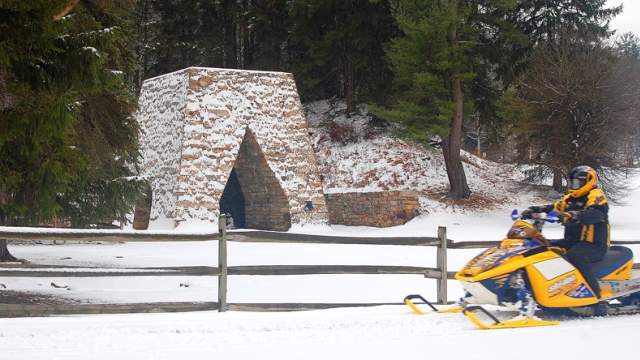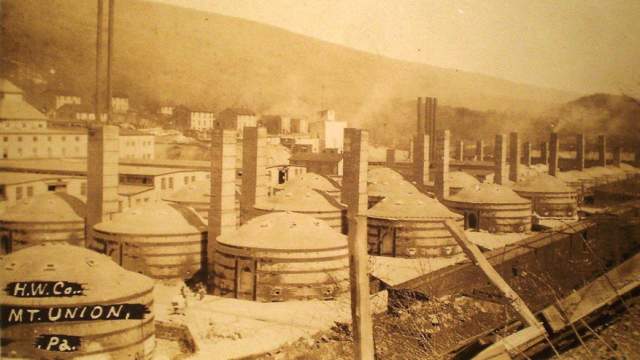History of manufacturing, tourism showcases region's resilience
From the late 1700s to the mid-1900s, the Industrial Revolution was in full swing and many new manufacturing processes took shape. America was ravenous for iron, then for steel, and the rich resources found in the hills and valleys of the Raystown Lake Region of Pennsylvania provided the perfect opportunity to feed the need.

IRON ALLURE
The Bedford Furnace was erected in 1785 in present-day Orbisonia, Huntingdon County, making it the first iron ore furnace west of the Susquehanna River Valley.
Bedford Furnace produced pig iron, stove plates and utensils. The success of early ironworks, deposits of iron ore throughout the region, plentiful forests that provided charcoal for fuel, and numerous streams for water power attracted other ironmasters. A growing population in the area combined with demand for iron products contributed to the rise of the iron industry. By the 1830s, this region became one of Pennsylvania's most important iron manufacturing areas.
During the same time, the East Broad Top Railroad and Coal Company in Rockhill Furnace (adjacent to Orbisonia) rose to meet the transportation needs of the iron industry. The narrow-gauge EBT was originally chartered in 1856 to mine and transport coal for the iron operation from the rich fields of nearby Broad Top Mountain. However, soon steel began to replace iron, so the EBT shifted its focus to Mount Union, Huntingdon County, transporting coal and ganister rock to the town’s fire brick plants.

FLEXING FOR STEEL
With the rise of America’s steel industry at the turn of the 19th century came the need for temperature-resilient bricks, primarily to line the steel mill furnaces. Mount Union’s silica brick became the staple of choice. Mined out of a quarry on nearby Jack’s Mountain, the ganister rock from the quarry was brought by rail car to town, crushed, mixed with a bonding agent, molded into bricks, and baked in large ovens.
Using the Juniata River as an artery of commerce, bricks were transported to market via the Pennsylvania Railroad, which followed the river as it built a mainline across the state, linking Philadelphia to Pittsburgh.
When its refractories were in full swing, Mount Union was known as the Silica Brick Capital of the World, helping Pennsylvania earn the title of “Steel Capital of the World,” a designation the Commonwealth enjoyed for more than 100 years.
PROGRESS: A SOMETIMES-BITTER PILL
By the 1950s, however, natural gas became a cheaper fuel source than coal, and the EBT was forced to close its operation. Soon after, new methods for producing refractory brick as well as foreign steel imports contributed to the demise of the Mount Union silica brick refractories in the 1970s-early 1990s.
As industrial manufacturing operations began to fade into the region’s sunset, a new tourism industry was dawning, one that would honor the past while creating fresh opportunities for responsible growth into the future.
THE TOURISM FRONTIER
Raystown Lake, dubbed the “Crown Jewel of Pennsylvania,” was dedicated by Vice President Gerald Ford on June 6, 1974, the culmination of nearly 40 years of legislating, planning, negotiating and construction.
While the primary goal of the vast Raystown Lake project was flood control, there was no doubt the unparalleled beauty of 118 miles of unspoiled lake shoreline would draw visitors to recreate in the region.
Numerous recreation areas and amenities were built to attract and accommodate tourists. Today, the lake draws more than 1.5 million visitors per year to its 8,300 acres of open water and the protected land that surrounds it. The water provides the perfect backdrop for weddings, events and gatherings as well as a free place to swim, fish, hunt and water ski. Since 2009, with the opening of the internationally acclaimed Allegrippis Trail System, the region has developed into a mountain biking mecca as well.
As visitors to the lake have increased over the years, other tourism growth opportunities have developed throughout the region.
For example, the EBT railroad reopened as a tourist attraction in 2020. Visitors can explore the EBT’s events and regular operating schedule at eastbroadtop.com.

Geology lovers and cave enthusiasts can delve deeper into the region’s rock history with a guided tour of Lincoln Caverns & Whisper Rocks, a natural wonder and public attraction along Rt. 22 just outside Huntingdon. Currently celebrating its 90th Anniversary, tour details and more information about the caverns are available at lincolncaverns.com.
Visitors can step back in time with tours at local museums such as Swigart Automobile Museum – America’s Oldest Antique Automobile Museum, Isett Heritage Museum, Broad Top Area Coal Miners Museum and others. Visit raystown.org/museums for a full list.
Many other attractions, from historic sites and farm tours to parks and trails, offer an unforgettable experience to visitors exploring the region.
History has shown that change is inevitable. But so is the grit, resilience and value created by those who call the Raystown Lake Region home.
